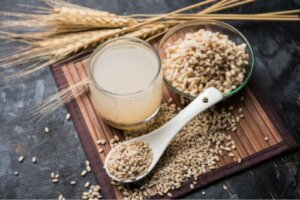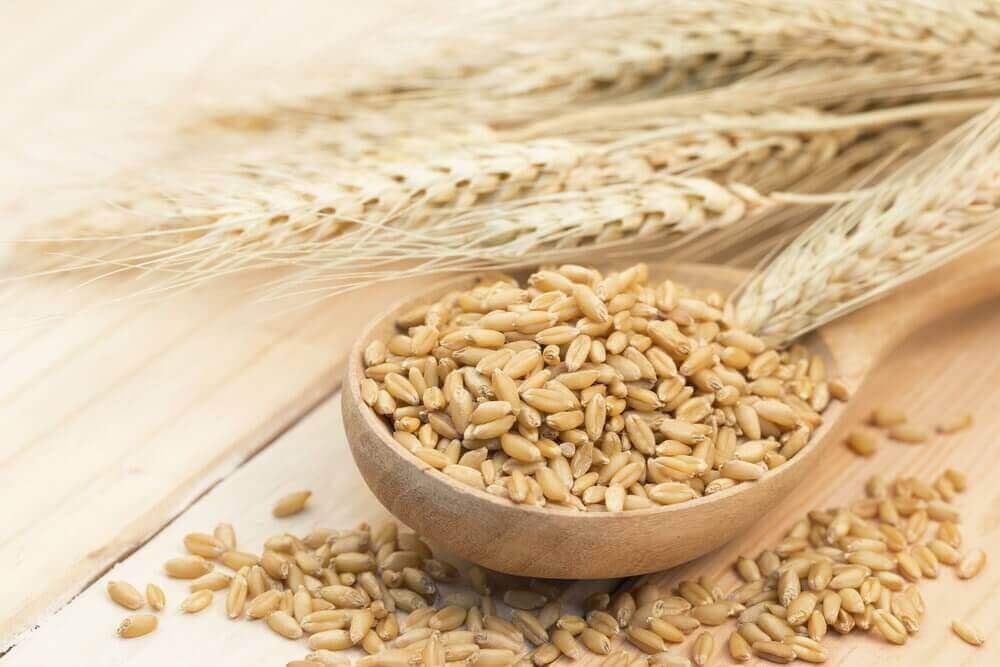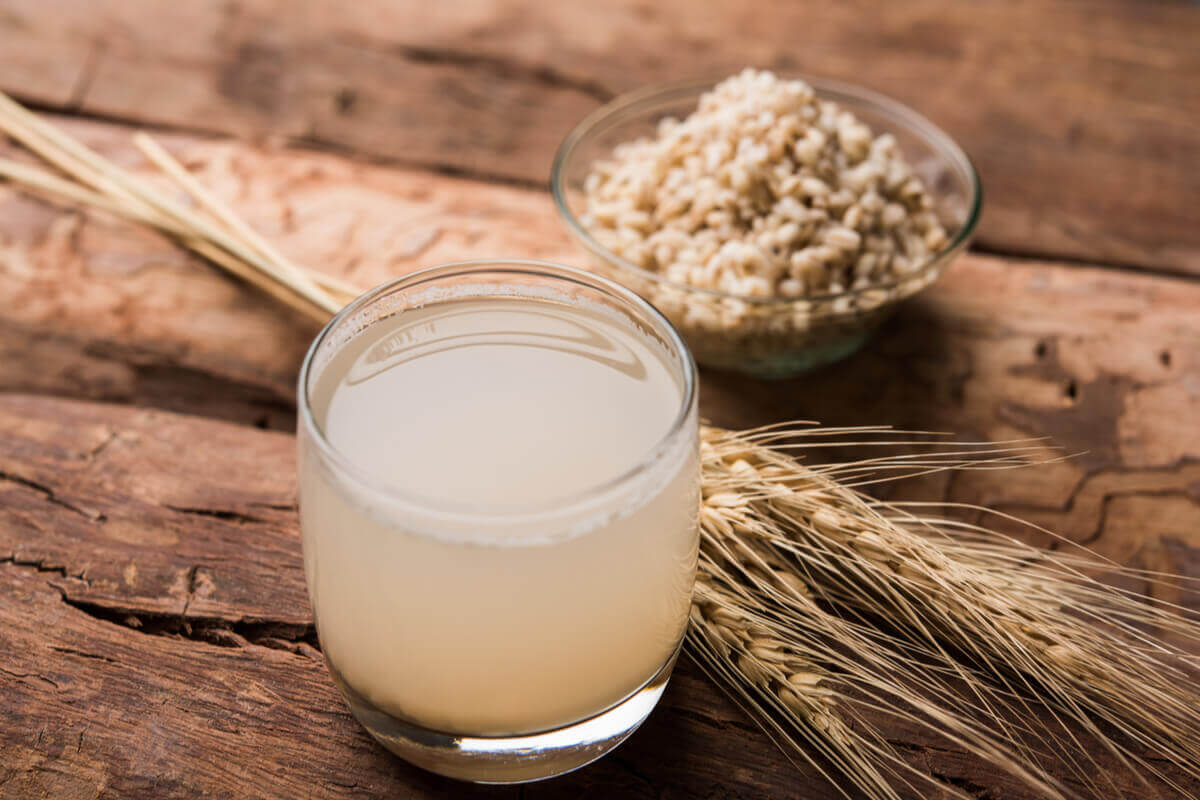Barley Water: Benefits, Contraindications and Recipe


Written and verified by the nutritionist Anna Vilarrasa
Barley water is a refreshing drink with nutritional properties. It’s typical of a few regions of Spain and some Central American countries.
Although it has recently become fashionable thanks to its health claims, not all of its benefits are backed by science. For this reason, it’s worth being alert and knowing a little more about it.
What’s barley water?
It’s a drink that’s prepared with barley boiled with water and a little lemon juice. Once ready, it can be flavored with cinnamon and even sweetened with sugar or honey.
We can find two different versions, because sometimes the water is filtered and the barley grain is discarded. Other times it’s kept in the drink.
It’s important to take this aspect into account, since the nutritional composition, energy value and health benefits are very different in both types. The main reason for this is that when the barley grain is discarded, the fiber is also lost.
5 benefits of drinking barley water
In many of the places where this drink is famous, people consume it thanks to its refreshing properties, but also for the positive effects it can have in the prevention of some diseases. As we said, this applies if the drink contains barley grains.
1. Contribution of nutrients
Barley is one of the oldest grains known and today it’s consumed in regions of the Near East, Northern Europe and South America.
Although many people are familiar with it because of its use in brewing beer, it actually has a very relevant nutritional composition, so it’s worth taking it into account as one more food in the diet. The following contributions stand out:
- Presence of soluble fiber
- Folates and other B group vitamins (B1, B3 and B6)
- Minerals and trace elements such as potassium, iron, magnesium, phosphorus, selenium, zinc and copper
- Antioxidants

2. Helps control blood cholesterol levels
In barley grains, there’s a very interesting component to combat high levels of cholesterol and other fats in the blood: beta-glucans.
It’s a type of soluble fiber present in cereals, although prominently in barley and oats over others such as wheat and rice. In a study published in the American Journal of Clinical Nutrition, a greater decrease in total cholesterol and LDL or bad cholesterol was observed in those diets containing barley compared to whole wheat.
So much so that the U.S. Food and Drug Administration (FDA) recognizes the ability of diets low in cholesterol and rich in fiber to reduce the risk of cardiovascular disease.
Read more: The FDA Approves a New Medication to Prevent Migraines
3. Regulation of glucose levels
There’s a review of scientific studies that found a positive correlation between the capacity of barley foods to control blood glucose levels after eating. This action is also due to beta-glucans which can lower blood cholesterol.
These two benefits (glucose and blood lipid control) together reduce the risk of cardiovascular disease and help protect the integrity of the walls of veins and arteries.
4. Helps in digestive processes
Barley grain has a good percentage of soluble fiber. This is beneficial for the digestive system, as it helps to push the food bolus and undigested residues along the gastrointestinal tract.
5. To control body weight
Again, it’s the presence of fiber that facilitates this action of unfiltered barley water. Many studies support the idea that diets high in this component promote satiety and decrease hunger.
In addition, taken between meals, it can be a good strategy to avoid snacking between meals with excess calories, fats or sugars.
Contraindications of barley water
Many foods and beverages are considered safe for the general public. However, some people may experience problems or uncomfortable sensations when drinking them. This also happens with barley water.
Therefore, the best recommendation is to introduce it gradually in the daily dietary routine and abandon its intake if any adverse effect appears. In addition, if you suffer from any disease or take medication, you must consult your doctor.
Digestive discomfort
One of its main positive components may also be the culprit of its drawbacks. The high amount of fiber found in unfiltered barley water can cause flatulence, gas, abdominal bloating, or stomach cramps.
High amounts of sugar and calories
Some homemade recipes and commercial brands contain high amounts of sugar or other sweeteners in their ingredients. Check labels carefully before choosing any beverage.
In addition, although it’s a drink made with water, when it’s not filtered, its main component is barley grains. These provide a moderate amount of energy, so it’s essential to limit intake.
Not suitable for celiacs
Barley grains are one of the cereals that contain gluten, therefore, it’s contraindicated in those who suffer from celiac disease.
Recipe for making barley water at home and how to drink it
To make barley water at home you need the following:
- 3/4 cup of pearl barley or barley grain
- 2 lemons
- 1/4 cup of honey or sweetener to taste
- 6 glasses of water
The first step is to rinse the barley under a stream of water until it runs clear. Put it in a pot with the water and the lemon peel. When the water starts to boil, lower the heat and let it cook for about 30 minutes.
Once this time has elapsed, you can strain it and keep it in a jar or glass bottle. Reserve the barley grains for later use: they can be mixed with yogurt, or added to a salad or vegetable soup.
You must remember that, without the barley, it’s a low-calorie drink (depending on the sweetener and the quantity used), but it loses all the properties provided by the fiber. You can also keep the barley with the water and drink it all together.
With the available scientific studies, it’s difficult to establish recommended amounts of adequate consumption. A publication of the European Journal of Clinical Nutrition details that barley beta-glucan can have different molecular weights and consequently its effect varies for the same dose.
What does seem reasonable is to advise moderate consumption in combination with a healthy diet and healthy lifestyle habits. These are the factors which allow us to receive all the benefits we mentioned before.

Barley water with grain
Barley water, either filtered or with the grains present, is a drink that offers the possibility of refreshment and hydration while still being delicious. But we have to be careful with how much we drink if it has added sugar or sweeteners.
When it’s homemade, a different and original flavor can be achieved by adding orange, fresh herbs or some spices at the time of bottling. Store it in the refrigerator, preferably in a glass jar or bottle.
Although there are potential benefits with scientific support, it’s better to introduce it into your diet little by little and in moderate quantities. Barley water provides valuable nutrients, helps control cholesterol and blood glucose, but it’s not a magic potion.
So the best way to get the most out of it is to integrate it into a varied diet based on fresh foods, with physical exercise, sufficient sleep and good stress control.
All cited sources were thoroughly reviewed by our team to ensure their quality, reliability, currency, and validity. The bibliography of this article was considered reliable and of academic or scientific accuracy.
- Abumweiss S.S, et al. β-glucan from barley and its lipid-lowering capacity: a meta-analysis of randomized, controlled trials. European Journal of Clinical Nutrition. Octubre 2010. 64:1472–1480.
- Behall K.M, et al. Lipids significantly reduced by diets containing barley in moderately hypercholesterolemic men. Journal of the American College of Nutrition. Febrero 2004. 23(1):55-62.
- FDA. Food labeling. Specific Requirements for Health Claims. Sec 101.81 Health claims : soluble fiber from certain food and risk of coronary heart disease. Abril 2020.
- Mcintosh G.H, et al. Barley and wheat foods: influence on plasma cholesterol concentrations in hypercholesterolemic men. American Journal of Clinical Nutrition. Mayo 1991.53(5):1205-9.
- Slavin J, Green H. Dietary fibre and satiety. Nutrition Bulletin. British Nutrition Foundation. Marzo 2007. 32(s1). 32-42.
- Tosh S. M. Review of human studies investigating the post-prandial blood-glucose lowering ability of oat and barley food products. European Journal of Clinical Nutrition. Abril 2013. 67(4):310-7.
This text is provided for informational purposes only and does not replace consultation with a professional. If in doubt, consult your specialist.








